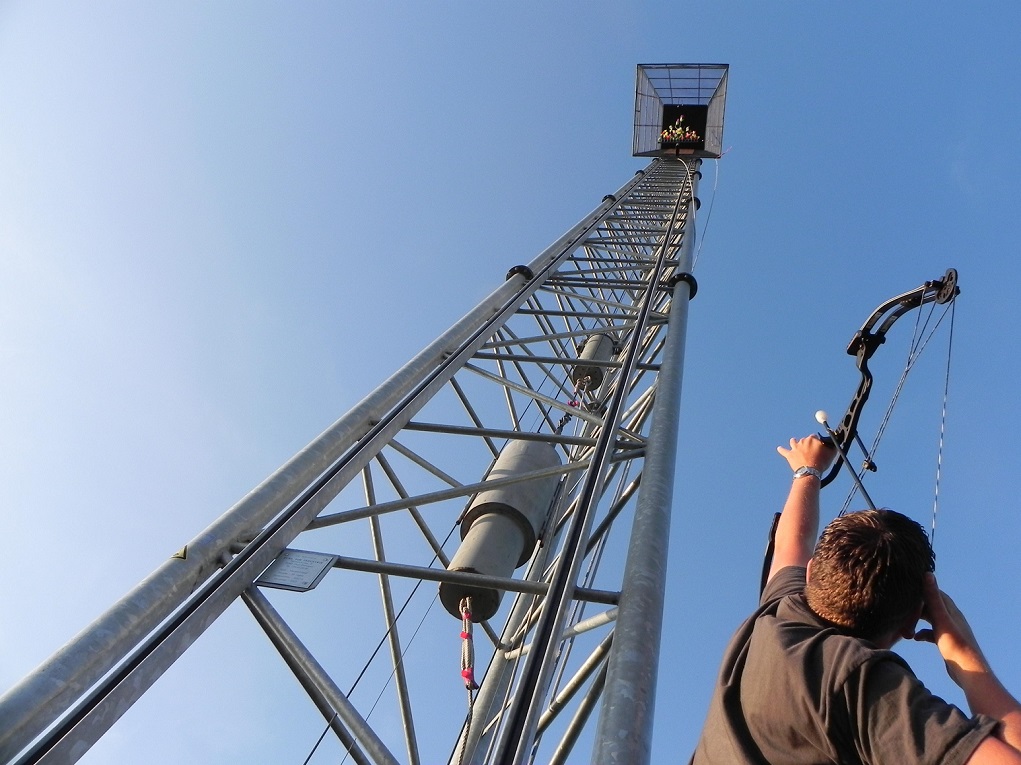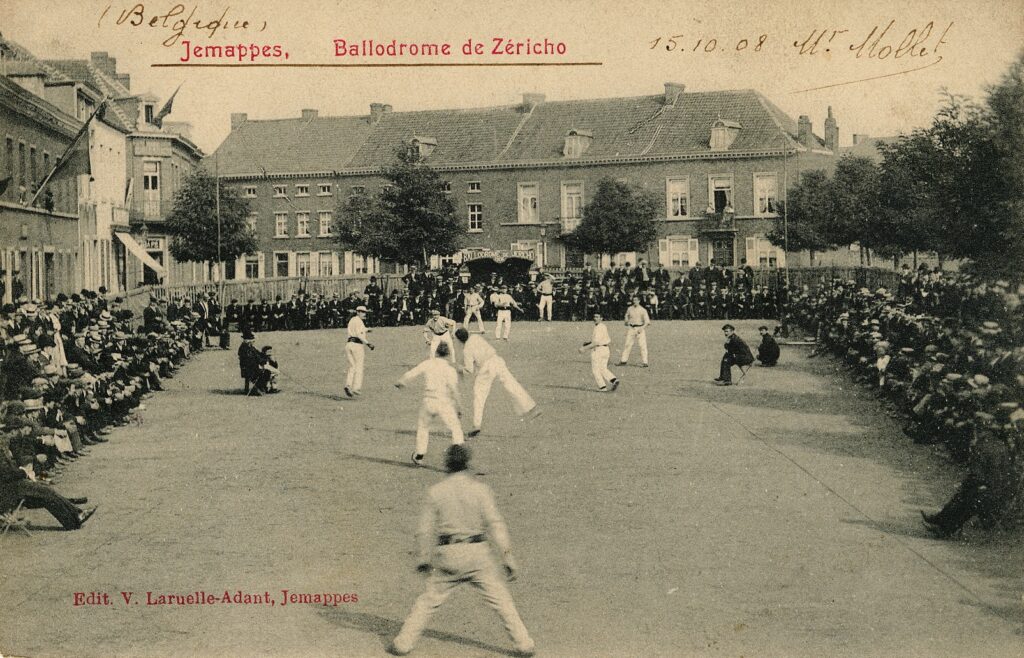Belgium boasts Olympic gold medals for both the equestrian long jump (Constant van Langhendonck, 1900) and live pigeon shooting (Leo de Lunden, 1900), as well as for more conventional sports such as the men’s hockey and women’s heptathlon.
Yet while the nation has excelled in cycling and judo and punched above its weight on the track thanks to the likes of Emile Puttemans and Ivo Van Damme, there’s little doubt that Belgium’s medal haul in Paris would be greatly enhanced by the inclusion of some of the country’s more singular pursuits and games.
Archery has been part of the Olympics since the first modern games were held in Greece in 1896 and Belgium has done remarkably well at it collecting 21 medals. Sadly, the International Olympic Committee (IOC) has steadfastly ignored a less conventional version of the sport, popinjay, or, as it is known in Dutch, staande wip.
This involves firing arrows at targets set on a tower high above your head. Since arrows come down as well as go up, it is by no means the safest way to shoot them, which may explain why popinjay has pretty much died out everywhere in Europe except Belgium, the Netherlands and a couple of places in Scotland.

Modern day staande wip or vertical archery
Flanders is a stronghold of vertical archery and you’ll see skeletal shooting towers looming mysteriously above fields in places like Eeklo and Havre. There’s even an exhibition of historic staande wip artefacts in the Archer’s House in Watten. In Scotland, popinjay is more or less a ceremonial event, but in Belgium, it is different, especially when the Flemish meet the Dutch in keenly contested international fixtures for which the 1970s parental catchphrase, “It’s all fun and games until someone loses an eye” might have been invented.
Golf’s ancestor
Golf has been a feature of the games since 2016 (there were earlier Olympic gold tournaments in 1900 and 1904 though sadly the event scheduled for the Antwerp Games of 1920 had to be cancelled due to a lack of entries). So far Belgium has made little impact, but that might be very different if the IOC were to include one of golf’s ancestors, jeu de crosse (also called jeu de chole and crossage).
Popular in the Wallonian Black Country and across the French border in coal towns like Valenciennes and Lens (the game features in Emile Zola’s mining novel, Germinal), jeu de crosse is played using clubs made from beechwood and iron that resemble one of those makeshift weapons the Flemish battered the French knights with at the Battle of the Golden Spur.
The capsule-shaped ball (the cholette), meanwhile, looks alarmingly like a huge suppository. As in golf, the object is to reach the target - perhaps a tree, a plank of wood or (this is Belgium after all) a beer barrel– located a couple of hundred metres away with the fewest shots. There’s an annual tournament on Ash Wednesdays in the Hainaut city of Chievres, and games are played regularly on the course belonging to the Societe Les Amis du Pic et du Plat in the village of Baudour near Mons. It’s a measure of how popular jeu de crosse once was in southern Belgium that the game has a patron saint, Saint Anthony. Saint Anthony is also the patron saint of lost things, which likely comes in handy when searching for your cholette in a ditch.
Basque pelota made a full appearance in the 1900 Olympics (Spain won, though, to be fair, they were the only country that bothered entering) and was a demonstration event in 1924, 1968 and 1994. Despite that, no place has yet been found for jeu de balle (also known as balle pelote), a sport that until World War Two was more popular in Brussels and Wallonia than football.

Jeu de balle at Jemappes
Played on ballodromes – long, oddly asymmetrical, funnel-shaped pitches usually located in town squares - jeu de balle features two teams of five players who strike a hard ball – about the size of the one used in squash – with heavily gloved hands. Although there is no net, to the untrained eye the game looks as if it might be the offspring of a one-night stand between tennis and volleyball. Though demand for parking places in town centres has severely curtailed the space allocated to jeu de balle (sadly no longer played in the Place de Jeu de Balle in Brussels, for example), there are still hundreds of clubs spread across Walloon Brabant, Hainaut, Namur, Luxembourg and the far eastern fringes of Flanders.
Petanque with cheese
The IOC has flirted with the idea of including lawn bowls in the Olympics since it featured as a demonstration event in 1988. This gives a window of hope to fans of the medieval sport of krulbollen. For centuries this 800-year-old pursuit was banned by the authorities for the damage it did to church windows, gravestones and public buildings. Yet its players would not be deterred and krulbollen is still played enthusiastically across West Flanders.
It’s a game that you might best be described as petanque played with cheeses. The big wooden discs that are rolled towards the target – a sturdy metal pin known as the staak – weigh around two kilos and are heavier on one side so they curve as they roll. Krulbollen is played on packed sand pitches outside cafes in the same small towns that produce Flanders’ cycling heroes, usually to a soundtrack of sage advice and wisecracks. Another West Flanders game featuring wooden cheeses, Trabol, is played in a concave alley that looks like a storm drain.
Billiards is campaigning vigorously to be included in the games of 2028, yet we have so far heard less clamour from adherents of the far superior game of jeu de fer. Every September for the past 50 years, in Tournai’s 17th century Halle-aux-Draps, 250 or so competitors gather for the national championship. The players –in teams of two - use what looks like sawn-off snooker cues to propel puck-like iron discs polished with paraffin down a narrow two-and-a-half metre table coated with marble dust towards the ‘etaques’ (goal in Picardian French) at the far end.
The path is not straightforward as the way is blocked by a series of iron hazards that include pins and a bridge. It’s a hushed affair, the silence punctuated only by the stifled yelps and groans of the participants and spectators. Yet though there are no flashing lights, buzzers or bells, the game being played under the vaulted ceiling of the great cloth hall is the grandfather of the one mastered with such brilliance by the deaf, dumb and blind kid from The Who’s 1969 rock opera Tommy. Jeu de fer traces its origins back to bagatelle, first presented to France’s King Louis XIV in the 18th century by the Comte D’Artois at his Château de Bagatelle. Its descendent is, of course, pinball.
Perhaps these sports are not dramatic enough to attract the attention of the IOC. Neither, one suspects would De Panne’s annual Championship of Gullscreeching or the ancient Flemish pursuit of vinkensetting – competitive finch chirping.

Vinkensport or competitive finch chirping
Dating back to the 16th century, vinkensport, sees competitors making a chalk mark on a long stick every time their prize finch – held in a neat wooden box at their feet - chirrups. The bird that sings the most times in an hour is the winner (in the 2007 contest, one finch was reported to have sung a record 1,278 times in one hour). In his 1994 BBC documentary on Belgium, Jonathan Meades observes a tad sarcastically that during such competitions “excitement often reaches fever pitch”. You’ll find a museum devoted to the sport in Hulste near Harelbeke.
Yet, if neither of these avian-related events is quite sexy enough for the Olympics you certainly cannot say the same of what to many fans remains the blue riband event of the Belgian sporting calendar - the annual collision of stilt-jousters in Namur. Dressed in Renaissance costumes and towering above the crowds on their wooden legs, the Echasseurs Namurois butt, kick and trip each other with the ferocious clacking sound of a roomful of grannies crocheting baby clothes. Anyone who has watched the annual contest for the Golden Stilt (held on the third Sunday of September) will know that this is a sport that has greater energy and produces more raw excitement than any amount of break-dancing, surfing and skateboarding. So come on Thomas Bach, what are you waiting for?

